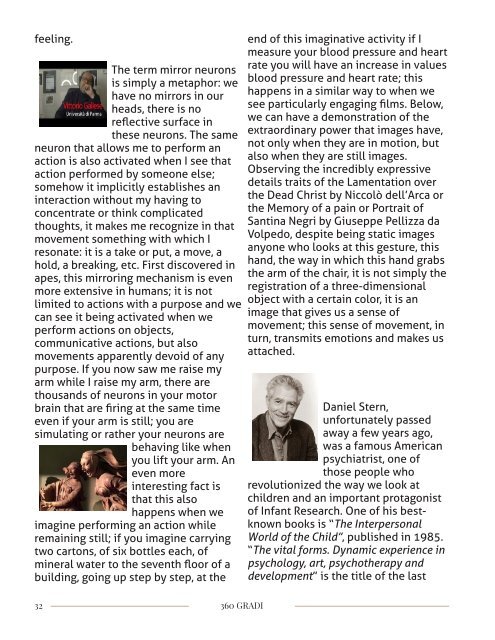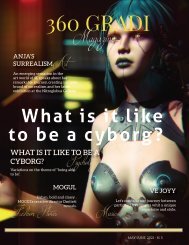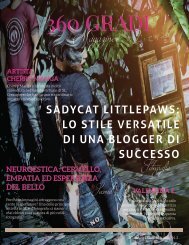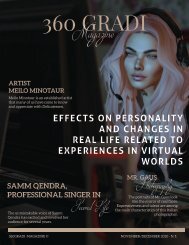360 GRADI MAGAZINE January/February 2021
The January/February 2021 issue of 360GRADI Magazine is online! All updates on our Fan Page: https://www.facebook.com/360gradisecondlifesionisti Don't forget to take our kiosk to put in your land! You won't miss an issue and you'll give a useful service to your visitors for free. Take your kiosk: http://maps.secondlife.com/secondlife/Petopia/217/216/4087 360 GRADI Magazine is the trendy, elegant, refined, and sophisticated publishing about Second Life (the virtual world by Linden Lab). Out every two months.
The January/February 2021 issue of 360GRADI Magazine is online!
All updates on our Fan Page: https://www.facebook.com/360gradisecondlifesionisti
Don't forget to take our kiosk to put in your land! You won't miss an issue and you'll give a useful service to your visitors for free.
Take your kiosk: http://maps.secondlife.com/secondlife/Petopia/217/216/4087
360 GRADI Magazine is the trendy, elegant, refined, and sophisticated publishing about Second Life (the virtual world by Linden Lab).
Out every two months.
You also want an ePaper? Increase the reach of your titles
YUMPU automatically turns print PDFs into web optimized ePapers that Google loves.
feeling.<br />
The term mirror neurons<br />
is simply a metaphor: we<br />
have no mirrors in our<br />
heads, there is no<br />
reflective surface in<br />
these neurons. The same<br />
neuron that allows me to perform an<br />
action is also activated when I see that<br />
action performed by someone else;<br />
somehow it implicitly establishes an<br />
interaction without my having to<br />
concentrate or think complicated<br />
thoughts, it makes me recognize in that<br />
movement something with which I<br />
resonate: it is a take or put, a move, a<br />
hold, a breaking, etc. First discovered in<br />
apes, this mirroring mechanism is even<br />
more extensive in humans; it is not<br />
limited to actions with a purpose and we<br />
can see it being activated when we<br />
perform actions on objects,<br />
communicative actions, but also<br />
movements apparently devoid of any<br />
purpose. If you now saw me raise my<br />
arm while I raise my arm, there are<br />
thousands of neurons in your motor<br />
brain that are firing at the same time<br />
even if your arm is still; you are<br />
simulating or rather your neurons are<br />
behaving like when<br />
you lift your arm. An<br />
even more<br />
interesting fact is<br />
that this also<br />
happens when we<br />
imagine performing an action while<br />
remaining still; if you imagine carrying<br />
two cartons, of six bottles each, of<br />
mineral water to the seventh floor of a<br />
building, going up step by step, at the<br />
end of this imaginative activity if I<br />
measure your blood pressure and heart<br />
rate you will have an increase in values<br />
blood pressure and heart rate; this<br />
happens in a similar way to when we<br />
see particularly engaging films. Below,<br />
we can have a demonstration of the<br />
extraordinary power that images have,<br />
not only when they are in motion, but<br />
also when they are still images.<br />
Observing the incredibly expressive<br />
details traits of the Lamentation over<br />
the Dead Christ by Niccolò dell’Arca or<br />
the Memory of a pain or Portrait of<br />
Santina Negri by Giuseppe Pellizza da<br />
Volpedo, despite being static images<br />
anyone who looks at this gesture, this<br />
hand, the way in which this hand grabs<br />
the arm of the chair, it is not simply the<br />
registration of a three-dimensional<br />
object with a certain color, it is an<br />
image that gives us a sense of<br />
movement; this sense of movement, in<br />
turn, transmits emotions and makes us<br />
attached.<br />
Daniel Stern,<br />
unfortunately passed<br />
away a few years ago,<br />
was a famous American<br />
psychiatrist, one of<br />
those people who<br />
revolutionized the way we look at<br />
children and an important protagonist<br />
of Infant Research. One of his bestknown<br />
books is “The Interpersonal<br />
World of the Child”, published in 1985.<br />
“The vital forms. Dynamic experience in<br />
psychology, art, psychotherapy and<br />
development” is the title of the last<br />
32 <strong>360</strong> <strong>GRADI</strong>











